Blockchain Development Outsourcing: Building a Team Amid a Talent Shortage and a New Wave of Crypto Hype
)
The talent shortage affects blockchain and crypto projects across the board. It’s also likely one of the reasons you’re looking into blockchain development outsourcing—and why you found this article.
Only 0.08% of the 28.6 million developers worldwide across all tech stacks and industries contribute to open-source crypto projects each month. The talent pool is incredibly small, making it even harder for companies to find experienced blockchain developers.
While blockchain technology is gaining recognition among major companies, skilled developers remain incredibly scarce. The demand for blockchain talent far outweighs the supply. Why is it so hard to find blockchain developers?
In this article, we'll explore the nature of blockchain talent shortage and how outsource comes to rescue. Read on to learn how to fill in the talent gap without breaking the bank, ensuring a level of control and communication similar to an in-house team.
Blockchain Talent Shortage Plaguing the Entire Industry
The industry's talent shortage is a multifaceted issue that makes it difficult for companies to quickly staff new projects and rapidly develop an MVP.
Why is this happening?
A primary reason is that companies focus on rapid deployment and fast execution of blockchain projects. In such cases, entry-level specialists are rarely needed, as they often delay rollouts and lack the experience to make significant contributions to the project; everyone seeks experienced developers with a few years in the blockchain niche.
For newcomers, blockchain technology has a very high entrance threshold. There is too much to learn, from understanding blockchain basics to mastering languages like Solidity, which is only used for smart contracts. As a result, many newcomers opt for better-documented, more in-demand technologies, such as mainstream front-end libraries and all-rounder languages like Python.
The global shift of blockchain developers has also contributed to the shortage. Ten years ago, the U.S. had the most blockchain developers, but today, Asia leads the way. Many Western developers have moved on to emerging tech like AI. This creates a challenge for Western companies—not only is local talent scarce, but hiring in Asia is also difficult due to unfamiliarity with the job market, business culture, and language barriers.
This makes skilled blockchain developers both rare and costly. According to Glassdoor and web3.career, blockchain developers with at least two years of experience earn 50% more than developers specializing in conventional tech stacks.
The talent shortage, the uncharted nature of the technology, and the high salaries compared to other development niches prompt companies looking to launch new products quickly to consider hiring blockchain outsourcing companies.
Why Outsource Your Blockchain Development?
First of all, let's explore why blockchain development outsourcing is important and how companies benefit from it.
Overcoming Crypto Brain Drain
Access to a global talent pool is the greatest advantage blockchain outsourcing brings to your project.
At its core, blockchain is a global technology, with developers from all over the world contributing to its evolution. In recent years, there has been a significant shift, with APAC being the leading market for cultivating blockchain talent.
For comparison, in 2015, the United States accounted for 43% of all blockchain developers in the world, but by 2024, this share has decreased to 24%. In 2024, Asia took the lead, hosting 32% of all specialists in this field. Europe is very close behind at 31%, rapidly closing the gap. 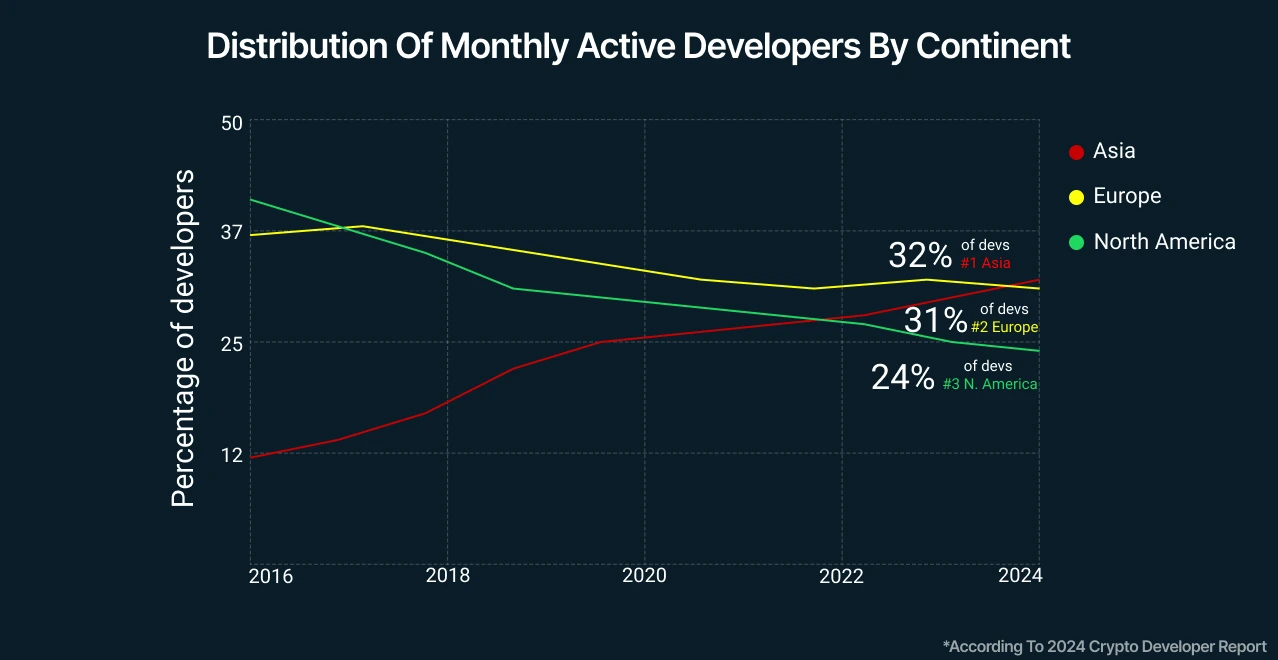
For the last two years, India has been the biggest country for new crypto developers. This clearly shows that the centre of blockchain development is increasingly shifting toward the Asian region.
Outsourcing connects Western companies with the Asian talent pool
Western companies are often at a disadvantage when staffing their blockchain development team. Locally, most developers focus on other technologies, making blockchain expertise scarce. Abroad, many skilled blockchain developers are already engaged in major projects, and Western talent teams often lack knowledge of regional hiring nuances.
Plus, there might be certain cultural and communication nuances. If you haven’t hired in-house teams from Asia before, establishing mutual understanding and effective collaboration can be challenging. Differences in work culture and business communication take more time to figure out compared to hiring local talent.
Blockchain software outsourcing companies help overcome these challenges by gathering teams that are already accustomed to Western business culture. The vendor's managers are there to help each step of the way, from project scoping to post-launch support.
Achieving the Cost-Quality Balance in Blockchain Development
According to a Deloitte study, cost optimization remains a key priority for companies using software development outsourcing. For instance, 34% of companies rely on outsourcing to optimize their costs. However, this is significantly less than in 2020, when 70% of companies cited the same reason.
Today, companies focus more on the cost-quality ratio and the outcomes of collaboration rather than solely on cost savings. However, cost-efficiency is still a hot question given the higher labor costs of blockchain developers compared to traditional IT specialists. Blockchain software development companies offer access to markets with lower labour costs and equally skilled developers. In Asia, total project costs can be up to three times lower than in the US or Europe.
Another key area of cost optimization is reduced hiring costs. Finding specialists for an in-house team requires significant time and resources. On average, it takes over 50 days to find and onboard a developer working with a regular tech stack. Considering the limited talent pool in the blockchain sector, this hiring timeline can easily double.
When staffing an in-house team, recruitment costs significantly impact the entire project cost. Talent specialists' salaries, third-party recruitment agencies, and operational expenses can easily reach 2–3 months of the candidate's salary. Bad hires happen, and they can end up costing twice as much as hiring the right candidate.

Outsourcing companies provide access to well-coordinated teams that work together on multiple projects. Depending on the vendor's capacity and your project needs, they can assemble a team within three weeks and kickstart your project. Additionally, outsourcing vendors reduce hiring risks because your organization doesn't have to deal with hiring and handling replacements if any team members leave during the project.
Navigating blockchain diversity
There are over 1,000 different blockchains, each with its own function, features, weaknesses, and fees. The diverse selection of blockchains makes developer shortage even more of a problem, because most blockchains support speicifc programming languages, making developers profile more narrow with a focus on a particular language.
Choosing the right blockchain is critical to a project's success, and having developers who understand how to work with it is equally essential.
No vendor can guarantee expertise in all 1,000 existing blockchains. However, teams specializing in blockchain development are proficient with major networks like Ethereum, Hyperledger Fabric, Polygon, Corda, BNB Chain, and TRON. With experience across these six blockchains, a team can handle most use cases. In fact, according to dApp Radar, two-thirds of all blockchain apps are built on these networks.
Hiring a blockchain development company simplifies the process of gathering a team with the expertise needed to work on the right technology for your project.
Faster time-to-market
A great idea is important, but validating it quickly is even more critical. Early feedback helps you determine if you're on the right path, need to introduce new features or pivot the app entirely.
If you're not a technical founder and can't build the app yourself, staffing can be one of the biggest hurdles to launching your MVP. Assembling a development team can take months, delaying your project's progress.
On top of that, there are other mundane, but essential tasks, like setting up reporting systems and task management tools to ensure clear visibility into the development process. These organizational challenges can take up a lot of time when you don't have an experienced project manager or scrum master in your team.
Outsourcing blockchain development companies can solve these issues because they:
- Assemble a team in just 2-3 weeks, getting your project moving quickly.
- Bring in teams that have already worked together, eliminating the time needed to adjust to each other’s workflows.
- Provide developers experienced in all major blockchains, so there’s no need for onboarding or technology ramp-up.
- Already follow best practices in project management and use tools that ensure visibility and transparency.
Additionally, reputable vendors often offer MVP development services. These include project scoping, consulting, and building the core features of your blockchain app. This approach lets you test your app's viability without breaking the bank and save resources for scaling or pivoting based on initial feedback.
Common Challenges and Misconceptions of Blockchain Development Outsourcing
Outsourcing blockchain development can be incredibly effective, but it’s not without its challenges. Let’s explore some common misconceptions and hurdles to help you navigate the process with confidence.
Misconception #1: "Outsourcing will ruin the quality of my product!"
One of the biggest concerns discussed on forums about outsourcing is the risk of ending up with a poorly functioning or underperforming product after outsourcing a project overseas.
This does happen, but it usually affects companies that prioritize cutting costs over quality. The good news is that the focus of outsourcing is shifting from being purely price-driven to prioritizing quality-based collaboration.
Companies with no outsourcing experience expect it to work like a magic black box: you input your project requirements, wait for some time, and then a first-class product appears out of nowhere. Unfortunately, large outsourcing vendors often perpetuate this myth.
In reality, the success of your collaboration heavily depends on the initial step—choosing the right vendor.
Opting for the largest players, often referred to as WITCH (Wipro, Infosys, Tata, Cognizant, HCL), may not be the best option. These companies are known for hiring people without prior commercial experience and presenting them as mid-level developers. They often claim expertise in all technologies but assign the same developers to jump between projects, regardless of specialization. If you’re lucky enough to get someone with niche expertise, it’s likely because they got that experience on a previous project where they were also misrepresented.
To avoid these pitfalls, take the time to interview key team members personally. If you’re not a technical person, consult with project managers and invest in hiring an independent developer or a vetting agency to conduct technical interviews.
The bottom line: Finding a trustworthy partner is one of the hardest but most critical steps in your project. Avoid large outsourcing companies, vet developers thoroughly, stay in touch with the vendor’s project manager, and actively participate in product demo days and sprint reviews.
Misconception #2: "We'll have constant communication problems!"
Many companies hesitate to outsource because they worry about language barriers, cultural differences, and time zone issues.
While these are valid concerns, outsourcing vendors have addressed these challenges over the years. Developers in major outsourcing hubs are fluent in English, and English proficiency levels in these regions have been steadily improving.
As for time zone differences, yes, challenges can arise if your vendor’s team is entirely based in one region, like Asia. While project managers are accustomed to having late client meetings, developers often work regular hours, which might extend the feedback loop.
To solve this, reputable vendors adopt a hybrid outsourcing model. For example, here at Kumo, we have R&D centres in five different countries. With over 150 blockchain developers supported by a broad talent network, our distributed teams ensure coverage across different time zones.
This model allows for seamless communication and quicker feedback loops. Developers can address comments and fix bugs the same day they are reported to the project manager, minimizing delays.
Regarding cultural differences, most of your interactions as a client will be with project managers and key developers who are accustomed to global business practices and experienced in client communication. The key is to choose reputable vendors with verified reviews from other clients. If no one mentions cultural or communication issues in reviews, you’re likely in good hands.
The bottom line: To overcome time zone and cultural challenges, partner with companies working under a hybrid model. It ensures you’re working with professionals located in regions that align with your time zone and cultural expectations.
Challenge #1: Hidden Costs and Budget Overruns
Budget lies at the heart of any blockchain outsourcing project, but hidden costs can easily throw ambitious plans off track. Companies tend to underestimate the real cost of outsourcing blinded by the idea of dramatic savings. This eventually leads to budget overruns that put the entire project at risk.
Hidden costs often creep in around unobvious things—setup fees, training, customizations, or project scope changes amid the development process. A vendor might give you an estimate that looks very promising on paper, but in reality, it doesn't cover unforeseen adjustments, multiple iterations of feature edits, or new feature requests. If the scope of your project grows, these unplanned expenses can make it tough to stick to your budget.
How to Avoid Hidden Costs
- Create a solid SLA: Draft a Service Level Agreement (SLA) that defines every service, cost, and fee for potential extra work. This removes any ambiguity and keeps surprises at bay.
- Proactively Monitor Progress: Monitor the project's timeline and tasks closely. Regular updates and open communication with the vendor help prevent scope creep and keep costs in check.
- Vet Your Vendor Carefully: When researching your potential vendor, review their estimates against similar projects they’ve delivered to ensure their pricing makes sense.
- Ensure your contract is comprehensive: A good contract covers all the details and includes clear terms for managing scope changes. This upfront clarity protects you from unexpected expenses later.
The Bottom Line Avoiding budget overruns comes down to smart planning and clear communication. Work with vendors who are transparent about their costs and prioritize regular updates. The earlier you address potential issues, the smoother your project—and your budget—will run.
Challenge #2: Vendor Lock-In
Vendor lock-in happens when a company becomes too dependent on a single vendor for software maintenance and updates. If you're relying solely on one blockchain development partner, you’re taking a big risk. What if they inflate prices, go out of business, or struggle to scale your application?
Staff turnover is an additional risk for outsourcing companies. If a key developer who worked on your project for years suddenly leaves—and there's no proper documentation or knowledge-sharing process on the vendor’s side—the entire project could be in trouble.
Other risks of vendor lock-in:
- Declining Service Quality: Vendors may become less responsive or face internal issues that affect performance.
- Geopolitical Risks: Regional sanctions or payment restrictions could make it impossible to continue working with your vendor.
- Rigid Pricing: The vendor’s pricing might be structured in such a way that makes it unfeasible to outsource certain tasks because the price becomes too high. Vendor lock-in is a sneaky problem because teams often assume switching vendors is easy. But in reality, migration comes with significant costs—procurement efforts, project scoping, onboarding a new provider, transferring documentation, codebase handover, and more. How to Avoid Vendor Lock-In
- Evaluate vendors: Once again, you need to consider your options carefully. Research and select a reliable provider to reduce the likelihood of needing to switch later.
- Retain ownership of critical assets: Ensure you always have access to your source code, documentation, and other essential project materials.
- Build an in-house safety net: During the cooperation, assemble a small skilled team that can maintain your project’s core functionality if the vendor relationship ends. They don’t need to replace the entire outsourced team, but they should be able to put out fires and prevent downtime.
- Lay the no-code foundation: If your app needs frequent updates (e.g. adding marketplace items), make sure non-technical team members can handle it without relying on developers.
- Consider geopolitical environments: In turbulent times it’s important to carefully consider the region you’re outsourcing your work to. Ideally, choose a provider with teams in multiple locations to minimize disruptions in case of external events affecting one of the development centres.
Following these suggestions is a great starting point to minimize vendor lock-in risks. Still, you have to stay flexible and agile to adapt to challenges that might arise during your outsourcing project.
Key Steps to Set Your Blockchain Outsourcing Project Up For Success
The cost of poor software quality in the U.S. alone is estimated to be at least $2.41 trillion, which is four times the size of the global outsourcing market—a staggering number.
Many businesses dive into blockchain software outsourcing without a clear plan, expecting the vendor to handle everything. However successful outsourcing requires careful preparation and ongoing management to get the best results.
Here are common steps teams need to take before and during the outsourcing journey:
1. Define clear project requirements
Before choosing a blockchain outsourcing company, ensure you have clear project goals, feature requirements, and business objectives. A well-defined roadmap keeps the process on track and helps avoid misunderstandings with the vendor.
It's just as important to communicate the business context along with technical details. If you treat your development partner as just a tech provider, you might end up with a functional product that doesn't fully serve your business needs. Experienced vendors have worked on many blockchain projects and can help bridge the gap between technical execution and business strategy—but only if they understand your goals.
How to Get It Right: 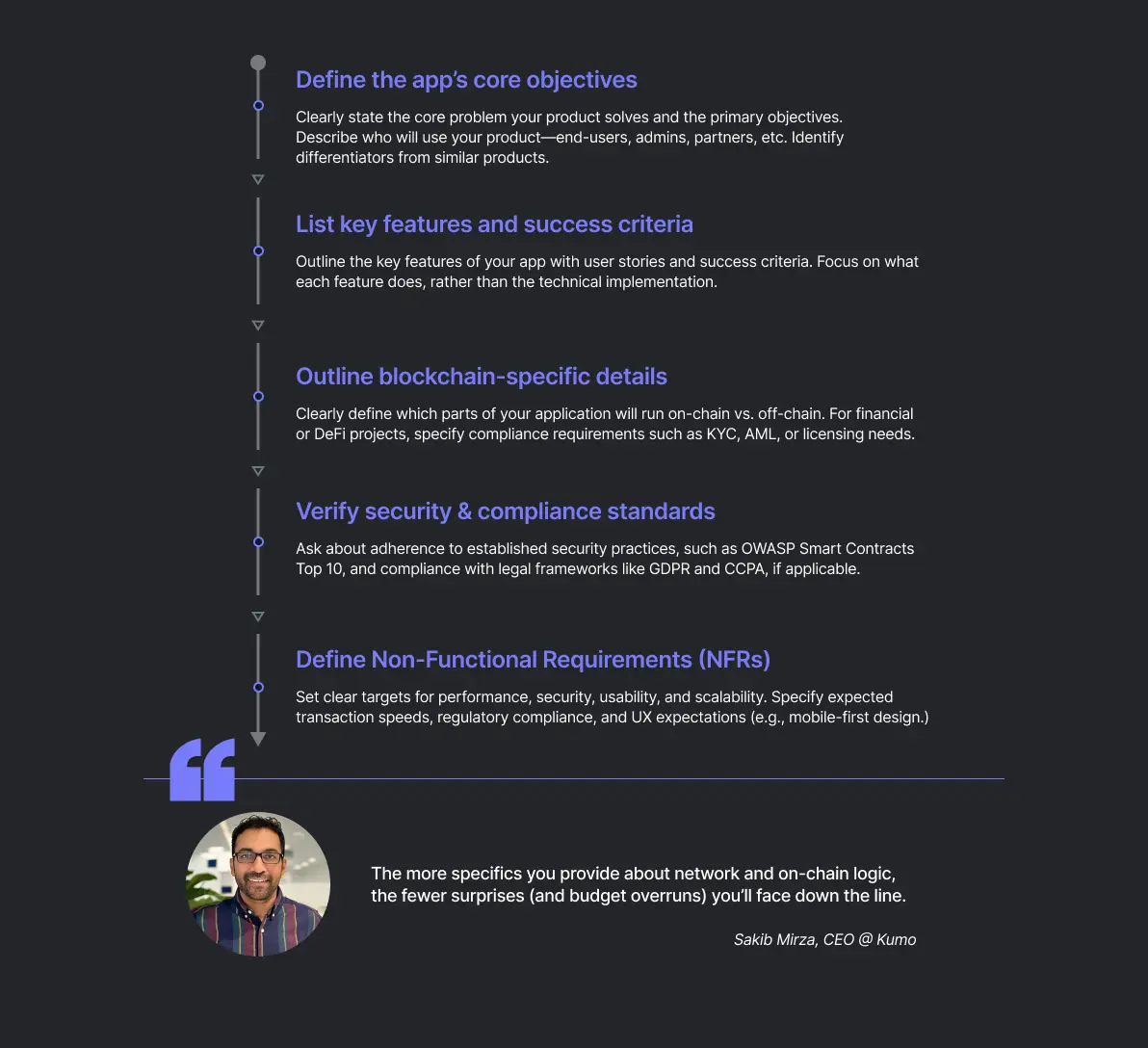
2. Choose the right blockchain development company
An experienced blockchain development partner can accelerate development, provide valuable industry insights, and ensure your project is built with scalability and efficiency in mind. On the other hand, picking the wrong partner can lead to misaligned expectations, technical debt, and costly delays.
Ideally, a vendor should understand your business vision, have a proven track record, and align with your working style. A common mistake is choosing a vendor just because they’re a large company. Many assume that a bigger team means faster staffing and more stability. However, large firms often inflate team sizes with junior developers, meaning only a couple of your team members may have real commercial experience.
Here’s how to find a trusted partner: 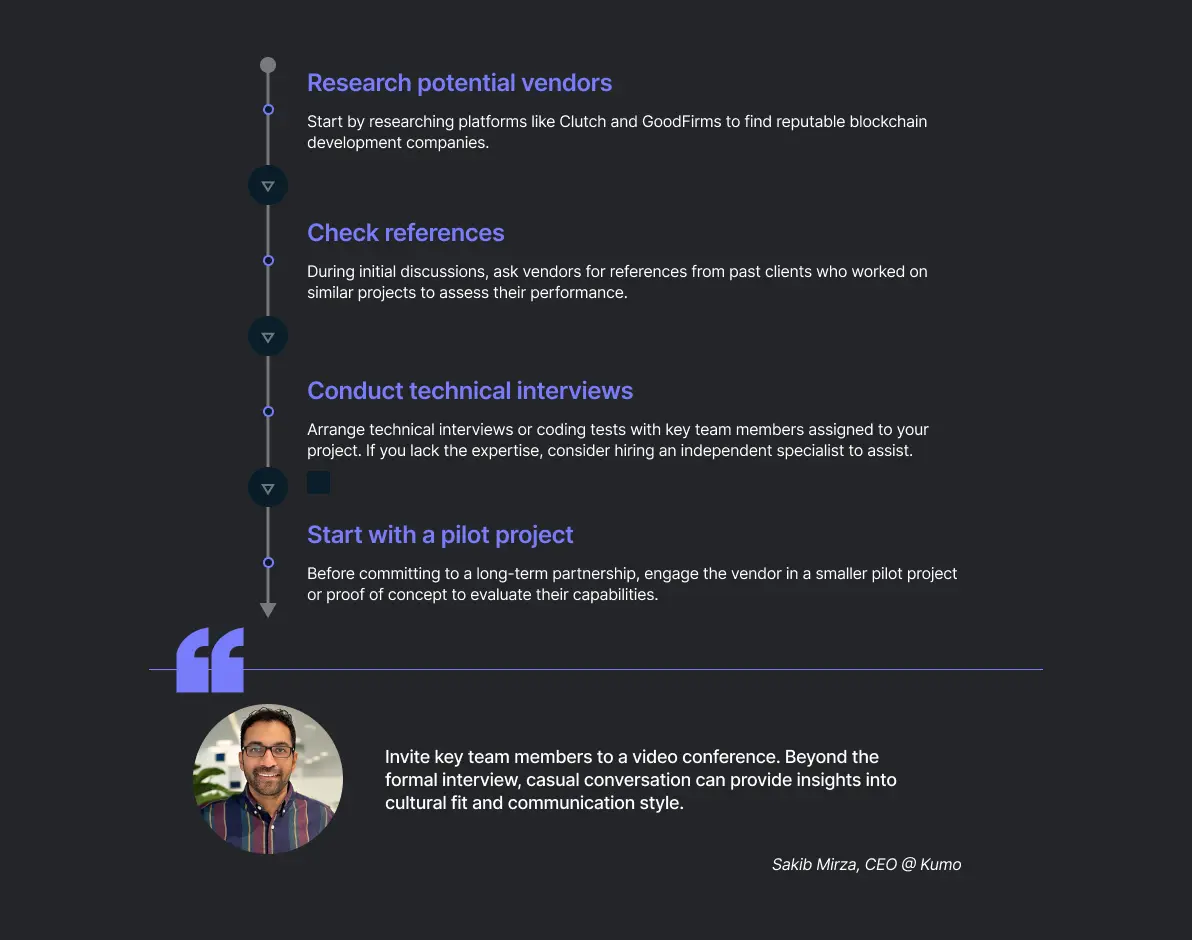
3. Foster Alignment and Collaboration with the Partner
When the deal is sealed and the project kicks off, do not step back and assume the vendor will handle everything based on the initial requirements. It’s crucial to stay involved to ensure the external team stays aligned with your vision of the product.
Regular check-ins help the external team translate your vision into technical features and deliver exactly what you expect. Unlike an in-house team, you won’t have the same visibility into daily operations, so structured communication—like weekly status calls, demo days, and sprint reviews—is essential for tracking progress, catching issues early, and keeping the team accountable.
Here’s how to stay on top of the development process:
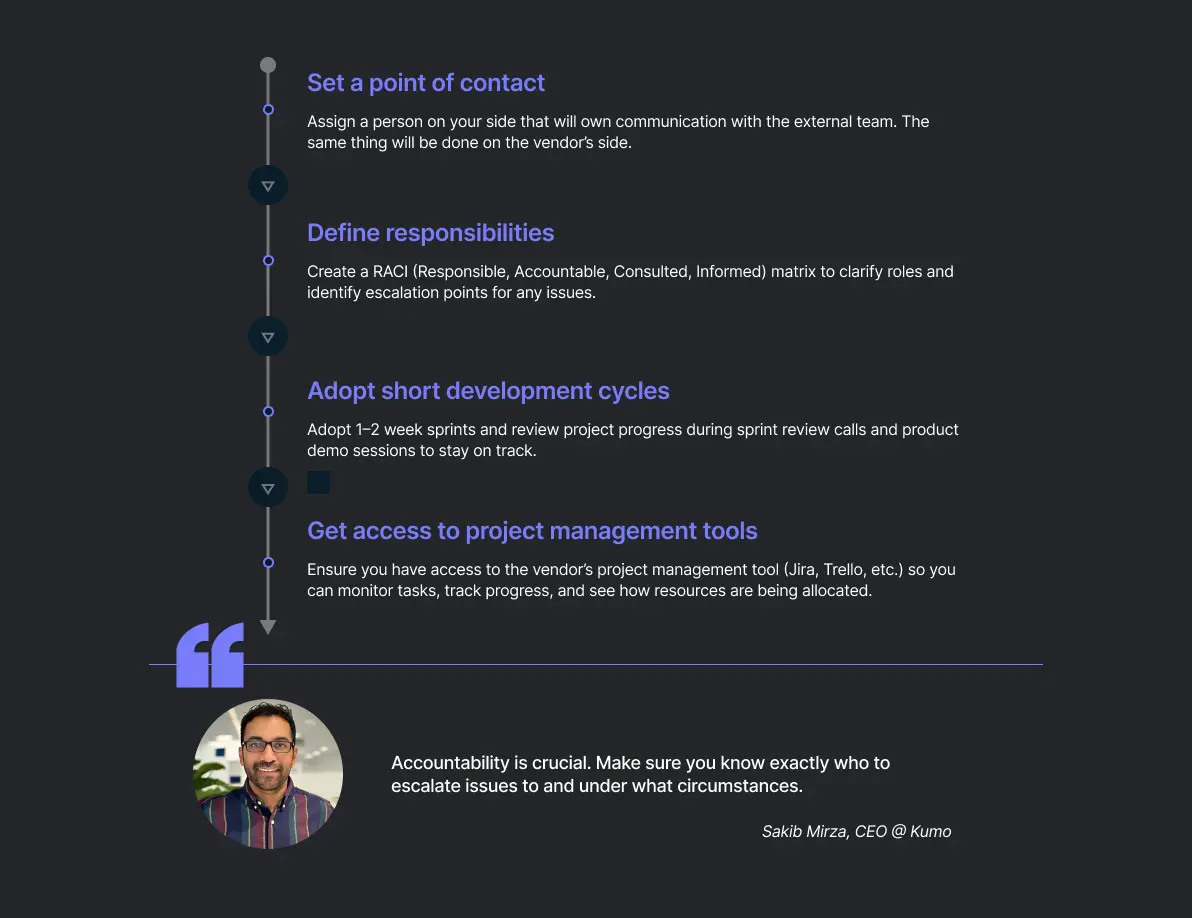
4. Thoroughly test the quality of the external team’s deliverables
Blockchain projects come with major financial and reputational risks, especially given the number of failed or fraudulent ventures that have left people out of pocket (think FTX Exchange).
Quality assurance of a blockchain project is critical to maintaining brand reputation, avoiding legal consequences, and providing top-notch user experience.
A trusted blockchain outsourcing company will provide dedicated QA engineers who review code written during each sprint and return it back for fixes if something isn’t working as intended.
However, blindly trusting your external team could be risky and there are some steps you can take to keep the team accountable for the quality of deliverables: 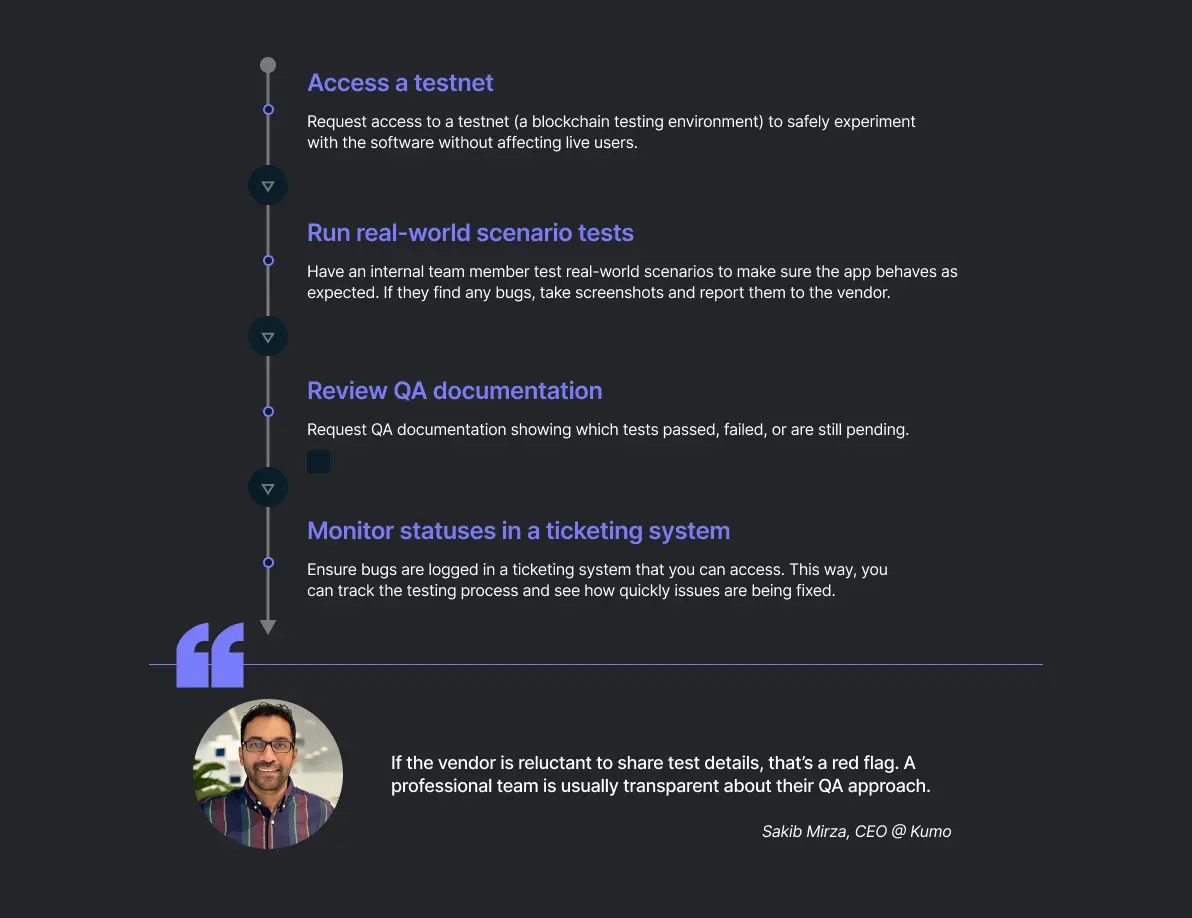
5. Clarify the terms of software maintenance and support upfront
Creating a well-defined support and maintenance framework with your blockchain outsourcing company will directly impact your product’s reliability and your team’s peace of mind.
The blockchain landscape constantly evolves, thus, regular security patches and updates will help protect your app from vulnerabilities and potential breaches. That’s essential if your app deals with finances and transactions.
Post-deployment support ensures you’re not left dealing with last-minute emergencies alone. It also helps keep your app competitive and prevents it from becoming outdated.
Here’s what to do when negotiating on maintenance terms: 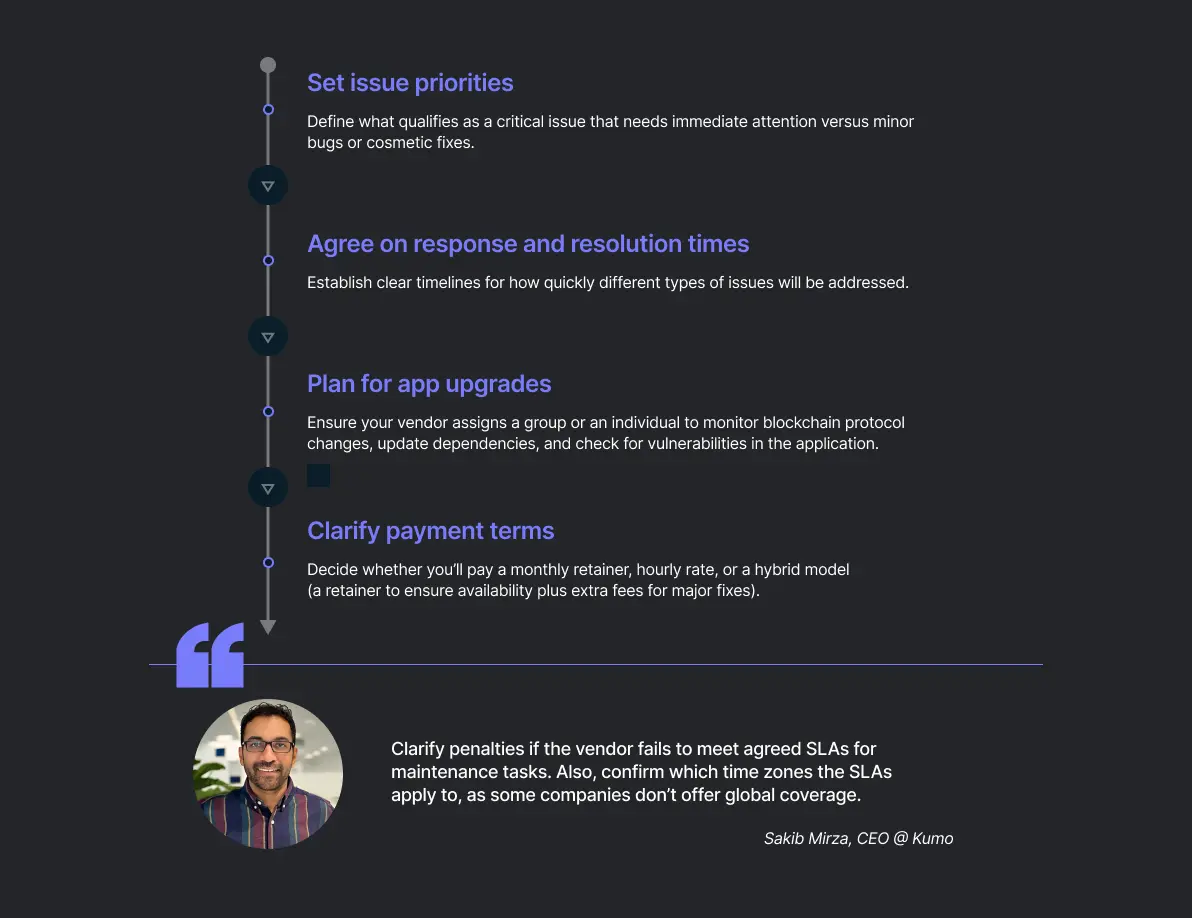
From Project Estimate to Post-Launch Support: Kumo Has You Covered
Launching a blockchain product is rarely a “one-and-done” sprint—requirements evolve, regulations tighten, and new chains appear almost weekly. Kumo was built for exactly this moving target:
Rapid scoping & transparent estimates Our solution architects map user flows, compliance checkpoints, and chain selection with you. Because wallet abstraction, royalty engines, KYC stacks, and other essentials are already baked in, you receive an accurate, fixed-price estimate in days—not months.
Weeks-to-production MVP Plug-and-play multichain routing, an asset-studio UI, and lazy-minting APIs let your in-house or outsourced developers focus on differentiation instead of boilerplate. Typical clients ship a branded, compliance-ready project in a few weekly sprints.
Enterprise-grade hardening Every contract ships fully audited, every API is rate-limited, and every rollout passes through Kumo’s CI/CD security gates. Our team tracks MiCA, Hong Kong’s ASPIR-E, CFTC guidance, and more, so your project always stays inside the regulatory lines.
Whether you lean on a full internal squad, an outsourcing partner, or a hybrid setup, Kumo removes the seven-figure plumbing cost—and the post-launch maintenance drag—that sink many blockchain projects.
Ready to bridge the blockchain talent gap with battle-tested infrastructure? Let’s talk about taking your project from idea to ROI with Kumo.
)
)
)
)
)
)
)
)
)